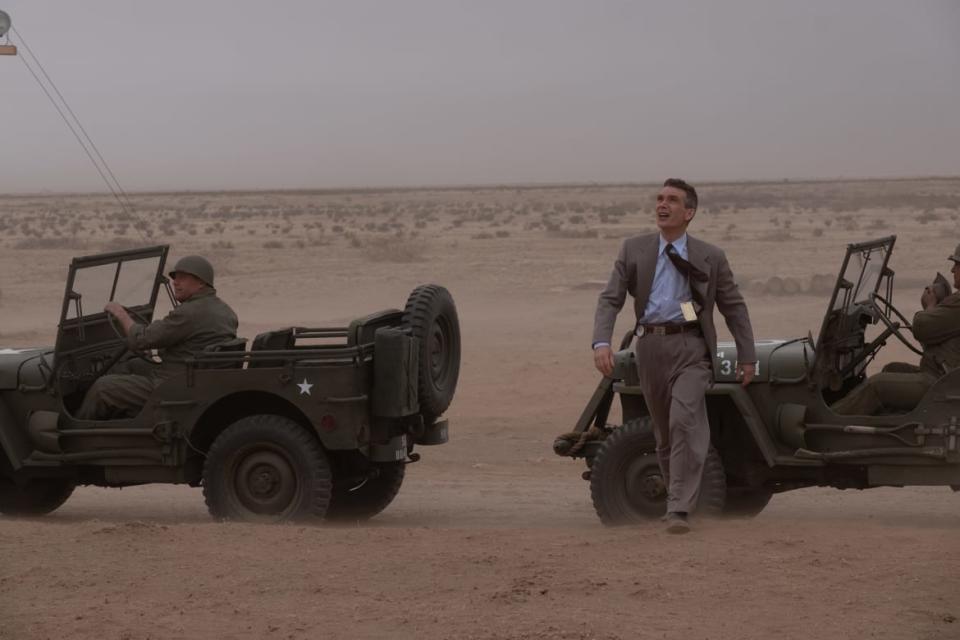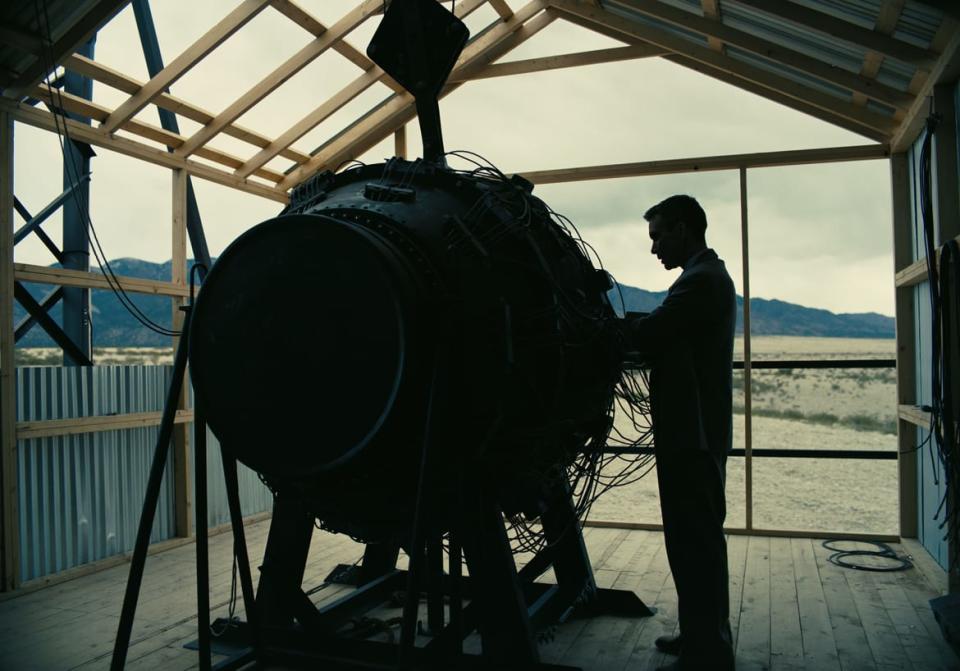Anatomy of a Scene: The Glory and Horror of the ‘Oppenheimer’ Atomic Bomb Launch

- Oops!Something went wrong.Please try again later.
- Oops!Something went wrong.Please try again later.
Divided to its very core, Oppenheimer is an intensely subjective character study of a genius defined by contradictions as well as a sprawling origin story about the birth of the modern world. For its opening two-thirds, the film builds at a breakneck pace to the instant in which both man and civilization are irrevocably changed by an act of fission: the July 16, 1945, “Trinity” test of the first atomic bomb on the plains of the Alamogordo Bombing and Gunnery Range, 210 miles south of Los Alamos. That scene is the initial climax of Christopher Nolan’s IMAX-sized masterpiece, and a bravura expression of the film’s intertwined formal and thematic ideas, all of which meld together and split apart in a big bang whose concussive power shakes reality itself.
Oppenheimer may be the story of a scientist figuring out a way to put theory into practice, but it moves at the speed of an apocalyptic thriller, with the fate of everyone and everything hanging in the balance of quantum physics pioneer J. Robert Oppenheimer’s (Cillian Murphy) race to beat the Nazis to atomic supremacy. That comes to a head in the New Mexico desert, where Oppenheimer and his colleagues hurry to meet the Potsdam Conference deadline set by President Truman (Gary Oldman) and pushed by their Manhattan Project director Leslie Groves (Matt Damon).
It’s the pivotal make-or-break moment that will determine the success of not only this groundbreaking scientific endeavor (and vital military undertaking), but possibly of World War II. Moreover, humanity itself hangs in the balance, since there’s a slim (“near zero”) chance that an atomic explosion will bring about Armageddon.
Nolan infuses this critical passage with the inexorable dread of witnessing the inevitable in all its paradigm-altering glory and horror. Piece by piece, technicians assemble the device, with Nolan cutting between that construction and sights of Oppenheimer and his team finalizing preparations for the Trinity trial run.
The sandstorm winds howl and the rains punish the arid land as Oppenheimer, his brother Frank (Dylan Arnold) and Groves discuss blast radiuses and the distance people will have to be from ground zero to avoid incineration and contamination, and late debates break out over whether the weapon will fire when soaked—leading to a monetary bet that’s so out of place (given the stakes of this venture) that it merely heightens the undertaking’s pressure-cooker hysteria. “Try not to blow up the world,” Groves recommends with a wryness that can’t mask the fear and stress engulfing everyone. “Break a leg,” says Oppenheimer’s wife Kitty (Emily Blunt) to her husband, the cliché so small and inadequate, it’s as if words have failed her in the face of such an epochal event.
When morning dawns and the downpours have subsided (as Oppenheimer, an expert on New Mexico weather patterns, accurately predicted), Oppenheimer puts the pedal to the metal, hurtling toward the second that the past will conclude and the future will commence. A clock ticks down as Nolan segues between countenances stricken with a distress and anticipation that’s so concentrated as to be almost unbearable.
‘Oppenheimer’ Review: Christopher Nolan’s Devastating, Explosive Magnum Opus
Positions are manned, final tasks are completed. In a shed with Oppenheimer, Kenneth Bainbridge (Josh Peck) stands over the cancellation button, his hand trembling with terror. At one outpost, Richard Feynman (Jack Quaid) and Ernest Lawrence (Josh Hartnett) take their seats in a car—as if at a drive-in movie—and Edward Teller (Benny Safdie) sits beside their vehicle in a chair, coating his face in glistening UV-protecting sunscreen and donning sunglasses to shield his eyes. Elsewhere, Isidor Isaac Rabi (David Krumholtz), Groves, and others lie on blankets, holding up silvery cards to protect their retinas from the coming explosion.
Ludwig Göransson’s score crescendos in a cacophony of shrieking Psycho-esque strings that are underscored by chest-rattling low tones, both heralding doom. Jennifer Lane’s edits accelerate and the film becomes a harried series of faces, so many faces, overcome by excitement and alarm. Finally, Nolan cuts back to Oppenheimer musing to himself, “These things are hard on your heart” (another piercing understatement that casts the enormity of it all into sharp relief) and then the clock turns to zero and it arrives, finally, in a flash of light that’s so bright it blinds, and so powerful it knocks the wind out of the universe and the breath out of the film, its characters and the audience, all of them struck silently dumb by the blossoming clouds and towering columns of fire that rise and cascade across the screen. Lawrence slightly recoils, Teller softly goes “pooh” with his lips, and Oppenheimer removes his goggles and, after steeling himself, opens his eyes to stare upon his handiwork.

The quiet is palpable, the awe overwhelming, and it’s shattered by a boom and blasts of air and sand that are as thunderous as the preceding hush was oppressive. Cheers, handshakes, and cries of “it worked” ensue, with Teller (a man who covets an even greater bomb) smiling, Rabi looking far less enthusiastic, and Oppenheimer overcome with the dazed joy of an inventor who has pulled off—and witnessed—a miracle. It’s the alpha and the omega, an end and a beginning. As befitting Oppenheimer’s fixation on dichotomies, Nolan envisions it in heightened contrasts: loud and noiseless; swift and patient; exhilarating and dismaying; close-up and panoramic; and triumphant and tragic, the last of these embodied by Oppenheimer’s legendary quote of the Bhagavad Gita upon the completion of his creation, “I am become Death, the destroyer of worlds."
A woozy celebration ensues, followed by Oppenheimer being informed by a military officer, “We’ll take it from here.” With that, Oppenheimer steps forward into its new day, which is also like its prior one, with Murphy’s physicist both inherently altered and forced to figuratively re-experience Trinity at a celebratory speech wracked by light, then silence, and finally a roaring boom—a manifestation of his dawning guilt over what he’s done.

The closing hour of Nolan’s film is a bifurcated, chronologically fragmented study of the cataclysmic chain-reaction aftermath of its centerpiece, from which there is no recovery, for Oppenheimer or anyone else. As Nolan so brilliantly evokes, the maiden atomic bomb has transformed everything, begetting in its apocalyptic fire and brimstone a tomorrow that will never be like yesterday, and yet will also always be defined by July 16, 1945. In that respect, Oppenheimer’s show-stopping “Trinity” sequence is a depiction of a specific dream realized and the birth of mankind’s greatest nightmare: fear of annihilation, ever-present and eternal.
Liked this review? Sign up to get our weekly See Skip newsletter every Tuesday and find out what new shows and movies are worth watching, and which aren’t.
Get the Daily Beast's biggest scoops and scandals delivered right to your inbox. Sign up now.
Stay informed and gain unlimited access to the Daily Beast's unmatched reporting. Subscribe now.

